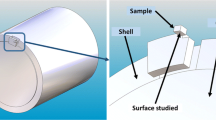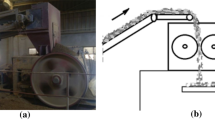Abstract
High-chromium white cast iron is a common material for the manufacture of the work rolls used in the finishing stands in hot strip mills. The high temperature oxidation behaviour of as-cast and heat-treated high-chromium white cast iron was studied by gravimetric means at 650 °C in atmospheres that included dry air and a mixture of dry air and water vapour. For both environmental and material conditions, the oxidation rate of the alloys was represented by parabolic trends and the oxidation phenomenon was more obvious when the samples were oxidised in water vapour. Water vapour also influenced the chemical composition of the oxides formed in the alloy and under this condition, the oxide scale formed on the alloy contained the oxides FeCr2O4, (Fe,Cr)3O4 and (Fe,Cr)2O3. In contrast, the alloys exposed to dry air conditions only experienced the formation of FeCr2O4 and (Fe,Cr)2O3. It was found that the presence of water vapour and the chromium content of the alloys increased the oxidation rate by a mechanism that involved chromium depletion of the oxide as a result of hydroxide formation. The differences observed in the oxidation behaviour of the alloy are discussed in terms of the composition of the oxidant atmosphere and the metallurgical condition of the specimens.
Similar content being viewed by others
References
González V, Rodríguez P, Haduck Z, et al. Modelling Oxida tion of Hot Rolling Work Rolls [J]. Ironmaking and Steelmaking, 2001, 28(6): 470.
Sikdar S, John S. Simulation of Thermal History of Work Rolls of Finishing Stand in Hot Strip Mill: A Numerical Approach [J]. Ironmaking and Steelmaking, 2006, 33(6): 493.
Kato O, Yamamoto H, Ataka M, et al. Mechanisms of Surface Deterioration of Roll for Hot Strip Rolling [J]. ISIJ Int, 1992, 32(11): 1216.
Colds R, Ramirez J, Sandoval I, et al. Damage in Hot Rolling Work Rolls [J]. Wear, 1999, 230(1): 56.
Choi J, Kim D. Mechanisms of Surface Deterioration of High-Ni Grain Roll for Hot Strip Rolling [J]. ISIJ Int, 1999, 39(8): 823.
Ramírez-Cuéllar J, Leduc-Lezama L A, Colds R. Mechanisms of Formation and Removal of the Primary Oxide in a Tunnel Furnace by the Descaling on a Compact Plant for Flat Products [J]. ISIJ Int, 2011, 51(3): 409.
Kim H, Lim J W, Lee J J. Oxidation Behaviour of High-Speed Steels in Dry and Wet Atmospheres [J]. ISIJ Int, 2003, 43(12): 1983.
Monteiro M J, Saunders S R J, Rizzo F C. The Effect of Water Vapour on the Oxidation of High Speed Steel, Kinetics and Scale Adhesion [J]. Oxid Met, 2011, 75(1/2): 57.
Garza-Montes-de-Oca N F, Colds R, Rainforth W M. High Temperature Oxidation of a Work Roll Grade High Speed Steel [J]. Oxid Met, 2011, 76(5/6): 451.
Rodenburg C, Rainforth W M. A Quantitative Analysis of the Influence of Carbides Size Distributions on Wear Behaviour of High-Speed Steel in Dry Rolling/Sliding Contact [J]. Acta Mater, 2007, 55(7): 2443.
Garza-Montes-de-Oca N F, Rainforth W M. Wear Mechanisms Experienced by a Work Roll Grade High Speed Steel Under Different Environmental Conditions [J]. Wear, 2009, 267(1): 441.
Bedolla-Jacuinde A, Rainforth W M. The Wear Behaviour of High-Chromium White Cast Irons as a Function of Silicon and Mischmetal Content [J]. Wear, 2001, 250(1): 449.
Molinari A, Straffelini G, Tomasi A, et al. Influence of Microstructure and Chromium Content on Oxidation Behaviour of Spin Cast High Speed Steels [J]. Mater Sci Technol, 2001, 17(4): 425.
Caplan D. Effect of Cold Work on the Oxidation of Fe-Cr Alloys in Water Vapour at 600 °C [J]. Corros Sci, 1996, 6(11): 509.
Pujilaksono B, Jonsson T, Heidari H, et al. Oxidation of Binary FeCr Alloys (Fe-2. 25Cr, Fe-lOCr, Fe-18Cr and Fe-25Cr) in 02 and in 02+ H2O Environment at 600 °C [J]. Oxid Met, 2011, 75(3/4): 183.
Laverde D, Gomez-Acebo T, Castro F. Continuous and Cyclic Oxidation of T91 Steel Under Steam [J]. Corros Sci, 2004, 46(3): 613.
Nakai M, Nagai K, Murata Y, et al. Correlation of High-Temperature Steam Oxidation With Hydrogen Dissolution in Pure Iron and Ternary High-Chromium Ferritic Steel [J]. ISIJ Int, 2005, 45(7): 1066.
Othman N K, Zhang J, Young D J. Water Vapour Effects on Fe-Cr Alloy Oxidation [J]. Oxid Met, 2009, 73(1/2): 337.
Jianian S, Longjiang Z. Tiefan L. High-Temperature Oxidation of Fe-Cr Alloys in Wet Oxygen [J]. Oxid Met, 1997, 48(3/4): 347.
Robertson J, Manning M I. Criteria for Formation of Single Layer, Duplex, and Breakaway Scales on Steels [J]. Mater Sci Technol, 1988, 4(12): 1064.
Author information
Authors and Affiliations
Corresponding author
Rights and permissions
About this article
Cite this article
Ramírez-Ramírez, J.H., Colás, R. & Garza-Montes-de-Oca, N.F. High Temperature Oxidation of a Work Roll Grade High-Chromium White Cast Iron. J. Iron Steel Res. Int. 20, 122–129 (2013). https://doi.org/10.1016/S1006-706X(13)60187-9
Received:
Published:
Issue Date:
DOI: https://doi.org/10.1016/S1006-706X(13)60187-9




